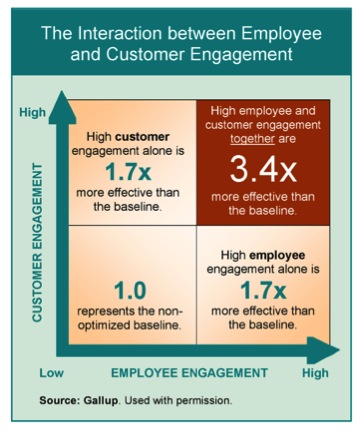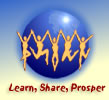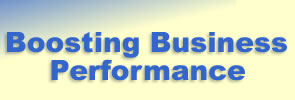How “Engaged” Employees Can
Turbocharge the Bottom Line
by Adele Sommers

Do you want to thrill your customers or clients and turn them into raving fans?
I’m sure you do, and so does every company! That’s why researchers at The Gallup Organization have long studied the powerful relationship between loyal, passionate, and deeply committed customers and a company’s bottom line.
What makes your most ardent customers so special? Gallup found that “highly satisfied” customers deliver 23% more profitability, revenue, and relationship growth than “satisfied” or “dissatisfied” customers do. And there are even more impressive findings when you examine the quality of the interactions between highly satisfied customers and an organization’s employees.
Why is this customer–employee interaction so vital? Gallup found that encounters between engaged employees and engaged customers contribute far more to a company’s financial success than either factor alone.
To test Gallup’s findings, ten companies followed a set of recommendations that Gallup derived from its data analysis. The result? Those companies outperformed their largest peers by 26% in gross margins and 85% in sales growth in one year!
But first, let’s explore what it means to offer praiseworthy products and services...
The Need to Eliminate Variability in Customer Experiences

Have you ever heard this familiar children’s saying?
“For want of a nail, a shoe was lost; for want of a shoe, a horse was lost; for want of a horse, a battle was lost; for want of a battle, a kingdom was lost.”
So states an underlying philosophy and related economic model that measures the losses to society due to poor or unpredictable product and service quality.
The farther products or services stray from perfection, the greater the negative impacts on society. Besides inconveniencing and aggravating customers and those around them, those negative impacts can ruin a company’s reputation and destroy its ability to stay in business.
Solving this problem entails finding ways to reduce and prevent variability in products and services, thereby producing consistently high quality. For example:
- For products, reducing variation means ensuring that every item produced conforms as tightly as possible to the ideal, which is as close to perfection as attainable. To achieve this coveted status in the manufacturing arena, quality initiatives such as Six Sigma have helped companies realize extremely low reject rates (“zero defects,” in essence) by eliminating variability in systems and processes.
 For services, reducing variation means completely satisfying all advertised promises, and providing excellent customer care each and every time a customer interacts directly with an organization’s support hotline or other human-based services. Even one disappointing experience can ruin a customer’s trust, confidence, and loyalty to the company. (Many of us can relate to that feeling as consumers!) For services, reducing variation means completely satisfying all advertised promises, and providing excellent customer care each and every time a customer interacts directly with an organization’s support hotline or other human-based services. Even one disappointing experience can ruin a customer’s trust, confidence, and loyalty to the company. (Many of us can relate to that feeling as consumers!)
So, in manufacturing, Six Sigma has helped pave the road to product excellence. But what exactly is the best way to offer consistently satisfying service experiences?
Good question. Gallup wanted to find out!
Another Way of Viewing Employee-Customer Interactions
To reveal the answers, Gallup researchers conducted studies over many years, and analyzed data on hundreds of companies and millions of customers and employees. They gained many eye-opening insights, some of which appear below.
 One critical finding pertains to meeting customer expectations. When we think about satisfying customers, are we referring to rational or emotional satisfaction? One critical finding pertains to meeting customer expectations. When we think about satisfying customers, are we referring to rational or emotional satisfaction?
- Rational satisfaction occurs from meeting the customer’s functional needs or specifications (what I call “quality in fact”).
- Emotional satisfaction results whenever a customer enjoys consistently helpful encounters with a company’s employees. This ultimately creates a deep personal loyalty to the business (what I call “quality in perception”). According to Gallup, these customer bonds involve four levels of increasing attachment: confidence, integrity, pride, and passion.
These emotional aspects are so strong, they carry extraordinary weight in the customers’ experiences — “feelings are facts,” explains Gallup. The stronger the relationships they develop, the greater their levels of customer engagement.
Here’s the critical point: “engaged” customers have the greatest desire to do more business — in greater volume, with more transactions, and over a longer period of time than other types of customers.
How much more? In one study, Gallup found that the most “emotionally satisfied” (highly engaged) customers spent 184% more than (almost twice as much as) either the “rationally satisfied” or the “dissatisfied” customers. This shows why engaging customers emotionally is so essential!
Bottom Line: Engaging Customers Also Requires Engaged Employees
What engages customers the most, and how do we achieve it? Gallup found that:
It’s not simply rational, automated transactions that excite customers, as efficient and accurate as those transactions might be. (The rational aspects are necessary to satisfy customers, but not sufficient by themselves.) Rather, it’s the employees who create the relationships that customers crave. Gallup found that the long-term success of any type of service — from fashion to high tech — seems to depend on developing strong personal relationships. Below are the key points:
To help employees successfully engage customers, companies must allow them to express their uniqueness and creativity while satisfying the customers’ needs, rather than trying to script every single aspect of their interactions.
 Employee-customer encounters are highly localized and can vary markedly from location to location within the same organization. Because of this variability, companies must measure and manage these encounters locally. Employee-customer encounters are highly localized and can vary markedly from location to location within the same organization. Because of this variability, companies must measure and manage these encounters locally.
Managing customers and personnel typically occurs in different parts of an enterprise. To optimize their employee-customer encounters, companies might need to reorganize to shift both groups under the same management.
Gallup’s single HumanSigma metric quantifies and summarizes the value of optimizing employee-customer contacts within each business unit or group. The optimized business units enjoy overall improvement and growth at 3.4 times the rate of non-optimized units. (Click the diagram at right to enlarge it.)
In conclusion, Gallup’s research shows that carefully managed interactions between engaged customers and engaged employees are among the most powerful drivers and predictors of profitability. These interactions depend on fostering an environment where employees have the latitude to creatively serve customer needs while at the same time building satisfying, long-lasting, emotional relationships. You may want to keep this research in mind when looking for ways to boost your own organization’s success!
Copyright 2020 Adele Sommers
|


